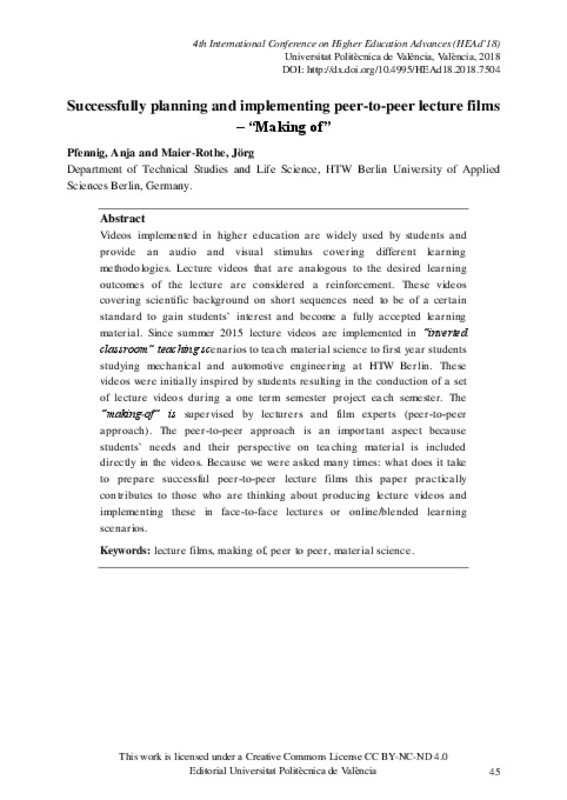JavaScript is disabled for your browser. Some features of this site may not work without it.
Buscar en RiuNet
Listar
Mi cuenta
Estadísticas
Ayuda RiuNet
Admin. UPV
Successfully planning and implementing peer-to-peer lecture films – “Making of”
Mostrar el registro sencillo del ítem
Ficheros en el ítem
| dc.contributor.author | Pfennig, Anja
|
es_ES |
| dc.contributor.author | Maier-Rothe, Jörg
|
es_ES |
| dc.date.accessioned | 2018-10-05T12:34:51Z | |
| dc.date.available | 2018-10-05T12:34:51Z | |
| dc.date.issued | 2018-07-02T12:34:51Z | |
| dc.identifier.isbn | 9788490486900 | es_ES |
| dc.identifier.issn | 2603-5871 | |
| dc.identifier.uri | http://hdl.handle.net/10251/109578 | |
| dc.description.abstract | [EN] Videos implemented in higher education are widely used by students and provide an audio and visual stimulus covering different learning methodologies. Lecture videos that are analogous to the desired learning outcomes of the lecture are considered a reinforcement. These videos covering scientific background on short sequences need to be of a certain standard to gain students` interest and become a fully accepted learning material. Since summer 2015 lecture videos are implemented in “inverted classroom” teaching scenarios to teach material science to first year students studying mechanical and automotive engineering at HTW Berlin. These videos were initially inspired by students resulting in the conduction of a set of lecture videos during a one term semester project each semester. The “making-of” is supervised by lecturers and film experts (peer-to-peer approach). The peer-to-peer approach is an important aspect because students` needs and their perspective on teaching material is included directly in the videos. Because we were asked many times: what does it take to prepare successful peer-to-peer lecture films this paper practically contributes to those who are thinking about producing lecture videos and implementing these in face-to-face lectures or online/blended learning scenarios. | es_ES |
| dc.description.uri | http://ocs.editorial.upv.es/index.php/HEAD/HEAD18 | es_ES |
| dc.format.extent | 10 | |
| dc.language | Inglés | es_ES |
| dc.publisher | Editorial Universitat Politècnica de València | es_ES |
| dc.relation.ispartof | 4th International Conference on Higher Education Advances (HEAD'18) | |
| dc.rights | Reconocimiento - No comercial - Sin obra derivada (by-nc-nd) | es_ES |
| dc.subject | Higher Education | es_ES |
| dc.subject | Learning | es_ES |
| dc.subject | Educational systems | es_ES |
| dc.subject | Teaching | es_ES |
| dc.subject | Lecture films | |
| dc.subject | Making of | |
| dc.subject | Peer to peer | |
| dc.subject | Material science | |
| dc.title | Successfully planning and implementing peer-to-peer lecture films – “Making of” | es_ES |
| dc.type | Comunicación en congreso | es_ES |
| dc.type | Capítulo de libro | es_ES |
| dc.identifier.doi | 10.4995/HEAD18.2018.7504 | es_ES |
| dc.rights.accessRights | Abierto | es_ES |
| dc.description.bibliographicCitation | Pfennig, A.; Maier-Rothe, J. (2018). Successfully planning and implementing peer-to-peer lecture films – “Making of”. Editorial Universitat Politècnica de València. 45-54. https://doi.org/10.4995/HEAD18.2018.7504 | es_ES |
| dc.description.accrualMethod | OCS | es_ES |
| dc.relation.conferencename | Fourth International Conference on Higher Education Advances | es_ES |
| dc.relation.conferencedate | Junio 20-22,2018 | es_ES |
| dc.relation.conferenceplace | Valencia, Spain | es_ES |
| dc.relation.publisherversion | http://ocs.editorial.upv.es/index.php/HEAD/HEAD18/paper/view/7504 | es_ES |
| dc.description.upvformatpinicio | 45 | |
| dc.description.upvformatpfin | 54 | |
| dc.type.version | info:eu-repo/semantics/publishedVersion | es_ES |
| dc.relation.pasarela | OCS\7504 | es_ES |








